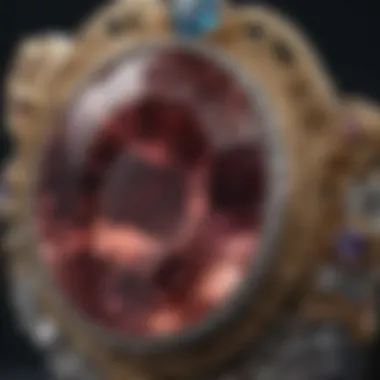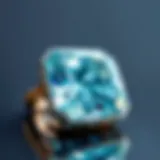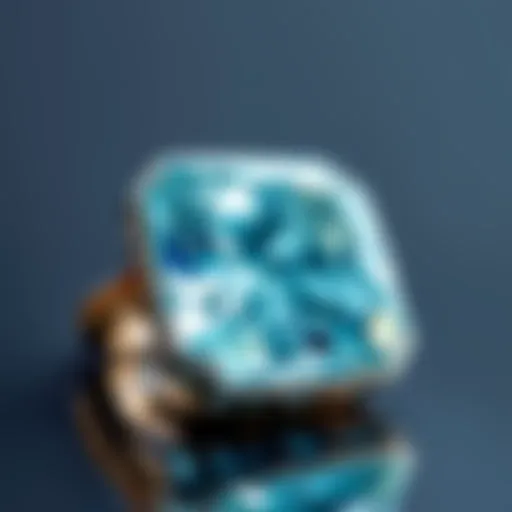The Girdle in Gemology: Importance and Implications


Intro
Understanding gemstones involves delving into various aspects that determine their value, beauty, and classification. Among these aspects, the girdle holds a prominent position. It serves not only as a fundamental part of the gemstone but also as a critical element in assessing its quality and appearance.
In gemology, the girdle is the narrow band around the stone, marking the division between the upper portion, known as the crown, and the lower part called the pavilion. The significance of the girdle lies in its impact on the gemstone's overall aesthetics, durability, and even its market value.
This article aims to provide insight into the intricate world of girdles within gemstones, addressing various facets such as their definitions, types, historical context, and practical assessment methods in the gemological arena. By understanding the technical details and implications of girdles, gemstone enthusiasts, collectors, and professionals alike can enhance their appreciation and knowledge.
Gemstone Overview
Definition and Characteristics
A gemstone is a precious or semi-precious mineral, rock, or organic material that has been cut and polished for jewelry or ornamentation. The term encompasses a vast range of materials, each with unique properties that contribute to its rarity and desirability. They may be categorized based on their physical and chemical properties, cut, color, and clarity.
The characteristics that define a gemstone can include:
- Color: The visual appearance and hue, which can be influenced by the mineral's composition.
- Clarity: The presence of inclusions or blemishes, affecting the stone's transparency.
- Cut: The way a gemstone is shaped, influencing its brilliance and light performance.
- Carat weight: A measure of mass that contributes to a stone's value.
- Hardness: Determined by the Mohs scale, indicating the material's durability.
Classification of Gemstones
Gemstones are often classified into two primary categories: precious and semi-precious.
- Precious gemstones: These include diamonds, rubies, sapphires, and emeralds. They are usually rarer and have the highest desirability in terms of beauty and value.
- Semi-precious gemstones: This category includes a broader array of stones such as amethyst, topaz, and opal. While less expensive and abundant, many semi-precious stones possess remarkable beauty and unique characteristics.
The classification of gemstones also extends into origins, natural stones versus synthetic or lab-created gemstones, highlighting the need for proper assessment practices in gemology.
Properties of Gemstones
Physical Properties
The physical properties of gemstones greatly affect their evaluation. These properties include factors like:
- Luster: How a stone reflects light. This can range from vitreous to pearly.
- Transparency: The degree to which light can pass through the stone, significantly influencing its visual appeal.
- Specific gravity: A measure of density, often used to distinguish between different gemstone materials.
Chemical Properties
Chemical properties are another critical aspect of how gemstones are categorized. Different minerals are composed of specific chemical compounds, leading to varied reactions under certain conditions. For example, the chemical composition of a sapphire primarily consists of aluminum oxide, which can create different colors due to trace elements. Understanding these properties assists in accurately identifying and appraising gemstones during evaluation.
Girdles are often overlooked, yet they play a vital role in how a gemstone is perceived in terms of quality and cut assessment.
Understanding Girdles
Girdles play a fundamental role in gemology. They are not just an insignificant aspect of a gemstone's structure; rather, they are essential to understanding a gem's overall quality and aesthetics. The girdle is the narrow band that encircles the gemstone, and it serves as a critical junction between the crown and the pavilion. Understanding girdles allows gemologists to assess cut, durability, and light performance of stones more effectively. As cutting styles evolve, so does the significance of girdle measurements, influencing not only professional evaluations but also consumer perceptions regarding value.
Defining the Girdle
The girdle is defined as the edge of the gemstone where the upper and lower halves meet. It is an important term in gemology and refers to the thin, usually horizontal band that runs around a stone. The girdle can vary in thickness and shape, influencing the durability and overall visual appeal of the gem. Most commonly, it is assessed during quality evaluations to determine if it meets industry standards. A well-cut girdle will ensure that the gem remains secure while allowing optimal light performance.


Girdle's Role in Stone Cut
The role of the girdle in stone cutting cannot be overstated. It contributes significantly to the cut quality, impacting the gemstone’s integrity and brilliance. When a gem is cut too thin, there is a risk of chipping, which can severely diminish the stone's value. On the other hand, a girdle that is too thick can result in unnecessary weight without any visual benefits, leading to less favorable proportions.
Effective stone cutting requires a balanced approach, where the girdle's thickness is carefully considered to enhance light interaction. Moreover, the shape of the girdle can also influence the overall aesthetic of the gemstone. Various styles exist, from rounded to flat, each imparting distinct characteristics to the finished piece.
The girdle is often an overlooked aspect of stone cutting, yet it holds significant implications for both durability and aesthetic performance.
Ultimately, understanding girdles in gemology encompasses both technical appreciation and informed decision-making for collectors and enthusiasts alike. It lays the groundwork for evaluating not just the physical attributes but also the emotional connection one has with each unique gemstone.
Types of Girdles
Understanding the various types of girdles is crucial for gemology as each type affects the aesthetic, durability, and overall quality of gemstones. This section will explore three main types of girdles: thin, thick, faceted, abrax and tapered. Understanding these types can greatly influence a gem's performance and appeal to enthusiasts, collectors, and designers alike.
Thin vs Thick Girdles
Thin girdles offer a delicate outline for gemstones, often enhancing their brilliance. However, this type may compromise durability. Thin girdles are common in diamonds, where they aim to maximize light return. Yet, they may be more susceptible to chipping.
In contrast, thick girdles provide additional protection and strength. While these girdles can minimize brilliance due to light interference, they may be favorable for items subject to wear. For gem collectors, selecting between thin and thick girdles often involves weighing aesthetic preference against the practical considerations of the gem's use.
A thin girdle can amplify shine but risk damage, whereas a thick girdle reinforces durability at a potential light performance cost.
Faceted vs. Abraxed Girdles
Faceted girdles are crafted with angular, flat surfaces. This design maximizes light reflection, contributing to the stone's overall sparkle. Faceted girdles often highlight the craftsmanship of a gem, making it more appealing to luxury markets. Many high-quality gemstones utilize this technique for enhanced aesthetic value.
Abraxed girdles, on the other hand, have a smoother, polish-like finish. They may possess a less dramatic visual influence but can yield a softer appearance. These girdles often win favor among those seeking unique textures and characters in gemstones. An abraded girdle could indicate a more rustic charm but might lack some brilliance compared to its faceted counterpart.
Tapered Girdles
Tapered girdles are another noteworthy variation. This type gradually thins out toward the edges. The tapering can enhance a gem's visual appeal by creating a more elegant and elongated appearance. Moreover, they can aid in the stone's overall light performance. However, tapering also requires precise cutting and design to maintain balance and symmetry throughout the gemstone. Proper tapering means a superior fit in various settings, making it a preferred choice among jewelry designers.
Evaluating Girdles in Gemstone Quality
Evaluating the girdle of a gemstone is a vital step in the assessment of its overall quality. This evaluation offers insights into various aspects, such as the stone's durability, light performance, and its aesthetic appeal. The girdle, which connects the crown and the pavilion of a cut gemstone, serves not just as a physical bridge, but also as a key player in the stone's functionality and beauty.
The importance of assessing the girdle goes beyond mere visual assessment. An understanding of how different girdle characteristics affect the gemstone can influence a collector's choices and a jeweler's designs. Therefore, taking the time to evaluate this element is essential for anyone engaged in the world of gemstones.
Influence on Durability
The durability of a gemstone is significantly impacted by its girdle. A well-proportioned girdle can enhance the resilience of the stone against chipping and breaking. Conversely, a girdle that is too thin can expose vulnerabilities that may jeopardize the integrity of the gem. For instance, thin girdles are more prone to damage, especially during setting or daily wear, leading to potential loss of the gem's value.
When assessing durability, consider these factors:
- Thickness: Ideally, a medium girdle thickness is preferred. It offers a balance between aesthetics and strength.
- Uniformity: An irregular girdle can create stress points, increasing the likelihood of damage.
In summary, the girdle's thickness and consistency play crucial roles in determining the longevity of a gemstone.
Impact on Light Performance


Light performance is another critical factor influenced by the girdle. The way light interacts with a gemstone can affect its brilliance and overall appearance. A girdle that is too thick may block light entry, diminishing the gem's sparkle. On the other hand, a perfectly executed girdle allows light to enter the stone efficiently, enhancing its brilliance and fire.
Light performance considerations include:
- Girdle Shape: Round girdles can encourage even light distribution, optimizing the gem's sparkle.
- Facet Alignment: Well-aligned facets around the girdle can enhance light reflection, creating beautiful visual effects.
Thus, understanding how the girdle shape and structure contribute to light performance is essential for gem enthusiasts and jewelers alike.
Girdle's Aesthetic Contribution
The aesthetic appeal of a gemstone is often linked to its girdle. While many may focus on the crown and pavilion, a well-designed girdle can add to the overall visual harmony of the piece. The girdle creates a boundary that can either accentuate or detract from the beauty of the gemstone.
In terms of aesthetics, consider the following:
- Proportions: Girdles that are too wide can make a stone appear bulky, while those that are too narrow may give an impression of fragility.
- Finishing: A smooth, well-finished girdle enhances the quality of the overall appearance. It provides a sense of refinement and professionalism to the cut.
To conclude, the girdle is much more than a mere connecting line within a gemstone. Its role extends to durability, light performance, and aesthetic appeal. Evaluating this important feature provides deeper insights into the quality and desirability of gemstones, benefiting collectors, jewelers, and enthusiasts alike.
The girdle holds a unique position in gemology, linking beauty with functionality.
Historical Perspectives on Girdles
The examination of girdles within the context of gemology not only sheds light on their technical aspects but also reveals their rich historical significance. Understanding the evolution of girdle design and their cultural importance offers gemstone enthusiasts and professionals deeper insight into the art of gem cutting and the symbolism attached to gemstones throughout history.
Evolution of Girdle Design
Girdle design has undergone significant transformations over the centuries. In ancient times, gemstone cutting was a rudimentary craft. The focus was primarily on polishing stones to enhance their natural beauty, with little consideration given to the exact intricacies of girdles. As gemstone cutting techniques evolved, the girdle became recognized for its role in determining a stone's overall quality and appearance.
With advancements in tools and methodologies, cutters began to understand that the girdle's thickness could influence a gemstone's durability and aesthetics. During the Renaissance, the invention of more precise cutting techniques allowed gem cutters to experiment with different girdle styles. This period marked the shift from flat girdles to more pronounced forms, which were designed to enhance light performance. Each iteration came with its own set of benefits, allowing gemstones to be showcased in new ways that appealed to both collectors and the elite society of the time.
In contemporary gemology, the relationship between girdle design and cutting precision is crucial. Today, technologies such as laser cutting have enabled more consistent and detailed girdle shapes, which affect not only the gemstone’s beauty but also its value in the market. Attention to girdle design remains a significant factor in gem assessments to this day.
Cultural Significance of Girdles
Girdles are not just technical elements; they also carry a wealth of cultural significance in various societies. Throughout history, different cultures have attached meanings and beliefs to gemstones, and the girdle, as a point of connection between the gem and its setting, plays a vital role.
In many ancient cultures, gemstones were believed to possess magical or healing properties. The girdle would often determine whether the stone could be effectively used in rituals or worn as a talisman. In Greek and Roman societies, the girdle was important for creating specific settings that honored objects of affection and power.
High-quality girdles were symbols of craftsmanship, conveying the importance of the gemstone itself. Girdles also influence how a gemstone is perceived. For instance, in modern jewelry design, a well-crafted girdle may elevate the overall appeal of the piece and reflect the designer’s skill. Additionally, the aesthetic choices in girdle design often resonate with contemporary cultural trends, making them significant in modern jewelry fashion.
"The girdle is a boundary that defines not just the stone, but the value it holds in human context."
Modern Technological Advances
The significance of modern technological advances in gemology cannot be overstated. In the context of girdles, innovations in cutting techniques and analytical tools have reshaped how gemstones are crafted and evaluated. These advancements not only enhance the precision of cuts but also affect the aesthetic appeal and functional properties of the stones. Understanding these technologies is important for gem enthusiasts and professionals alike, as they provide insight into the ever-evolving landscape of gemology.
3D Cutting Technologies
3D cutting technologies have revolutionized the way girdles are designed and manufactured. Unlike traditional methods, which rely heavily on manual skills and tools, 3D technology uses computer-aided design (CAD) and computer numerical control (CNC) machines for precise gemstone cutting. This shift allows for greater accuracy in creating uniform girdles, which directly impacts the overall quality of the gemstone.


The benefits of 3D cutting technologies include:
- Precision: It enhances the accuracy of the cut, resulting in better symmetry and proportion of the stone.
- Customization: Jewelers can create unique shapes and designs based on specific requirements.
- Efficiency: The process reduces waste, optimizing material use and cutting time.
Gemstone collectors and designers benefit substantially from these innovations, as they can now acquire stones with more refined girdle designs that maximize aesthetic appeal.
Software Innovations in Cut Analysis
Software innovations in cut analysis have emerged as key tools for evaluating girdles. These programs analyze a gemstone's cut quality by simulating light performance and assessing proportions based on advanced algorithms. Tools such as Gemvision and GemTools provide detailed reports on girdle characteristics, offering both quantitative and qualitative insights.
Key considerations in using software innovations for cut analysis include:
- Accuracy: Sophisticated modeling software reduces human error in evaluations, leading to more reliable grading.
- Visualization: Users can visually inspect the effects of different girdle settings on light return and brilliance before making physical cuts.
- Educational Resource: These tools serve as an educational platform for gemology students and professionals, enhancing their understanding of cutting dynamics.
By integrating software into the evaluation process, gemologists gain access to data-driven insights that assist in determining the best practices for girdle assessments. This evolution signifies a substantial leap towards a more scientific approach in gemology, marrying traditional craftsmanship with contemporary analytical techniques.
Best Practices for Assessing Girdles
When evaluating gemstones, understanding the girdle is not just an academic exercise. It has far-reaching implications for the practitioner. This section highlights best practices for assessing girdles, ensuring that gem enthusiasts and professionals alike can make informed decisions. Focusing on specific elements, it outlines the benefits and considerations essential to thorough girdle evaluation.
Tools for Girdle Evaluation
Accurate measurement and analysis of girdles hinge on the right tools. Gemologists use various instruments to assess the girdle's thickness, smoothness, and overall quality. Key tools often include:
- Micrometers: These provide precise measurements of girdle thickness, essential for assessing durability and cut quality.
- Gemmology Loupes: High-quality 10x magnification loupes help professionals to visually inspect the girdle for chips or irregularities.
- Protractors: Used to measure angles and ensure the girdle follows cutting guidelines effectively.
- Refractometers: They aid in determining gemstone properties, which can indirectly help assess girdle influence on performance.
Having the correct tools prevents errors in evaluation. Regular maintenance and calibration of these instruments is critical to ensure accurate assessments.
Approaches to Grading Girdles
Grading girdles involves a systematic approach to consider several key attributes. Here are the primary aspects to focus on:
- Thickness: Girdles are typically classified as thin, medium, or thick. Each classification affects durability and aesthetics. A standard practice is to measure them at multiple points to gauge consistency.
- Finish Quality: Inspecting for abrasions and burs can indicate the skill involved in cutting. A well-finished girdle enhances the overall visual appeal of the gemstone.
- Symmetry: A symmetrical girdle contributes to a balanced appearance. Any deviations may call for further inspection to identify potential craftsmanship flaws.
- Shape: While round shapes are common, other shapes can affect light performance and durability. Evaluating how the girdle shape affects overall design is vital.
Understanding these grading principles is crucial for determining a gemstone's quality and value. The girdle’s evaluation is often an indicator of overall craftsmanship, which ultimately influences market confidence.
Being thorough in these specific practices allows gemologists to present better assessments. This attention to detail is not only about the present evaluation but also shapes the conversations around future trends in jewel quality.
Epilogue
The significance of girdles in gemology cannot be overstated. As a vital aspect of gemstone evaluation, understanding girdles contributes significantly to the appraisal, selection, and overall value of gemstones. The girdle's attributes directly influence both the durability and aesthetic appeal of the stone. As gemstone enthusiasts, collectors, and jewelry designers expand their knowledge on this subject, they can make more informed decisions in their selections.
Summary of Findings
Several key points emerge from our exploration of girdles, including:
- Definition and Role: The girdle acts as the transitional area between the crown and pavilion of a gemstone, crucial in maintaining symmetry and structural integrity.
- Types of Girdles: Various girdle types—thin, thick, faceted, and sleek—affect performance and visual appeal. Each type carries its distinct characteristics impacting gemstone quality.
- Quality Evaluation: The girdle influences factors like durability, light performance, and aesthetic quality. Evaluating it properly ensures a gemstone can withstand wear and maintain its brilliance over time.
- Historical Context: Girdles have evolved in design and significance through different cultural lenses, reflecting advances in craftsmanship and technology over the years.
- Technological Innovations: The introduction of 3D cutting technologies and sophisticated software aids in accurately analyzing girdle structure, enhancing the precision of gemstone cuts.
Each aspect gathered in this examination provides a layered understanding of the girdle's influence not just on individual stones but on market values and consumer preferences.
Future Trends in Girdle Analysis
As gemology progresses, several trends may redefine how we view and assess girdles:
- Advanced Analysis Techniques: Innovations in spectroscopy and imaging technologies can lead to more precise evaluations of girdle characteristics.
- Customization in Girdle Design: With growing demand for unique gemstones, customized girdle designs may become more common, allowing for individualized aesthetic and structural choices.
- Sustainability Considerations: The gem industry is gradually incorporating sustainable practices. Future girdle analysis may focus on ethical sourcing and the environmental impact of gemstone cutting.
- Increased Consumer Awareness: As knowledge spreads among enthusiasts and collectors, a heightened demand for detailed evaluations of girdles and their implications will likely arise.



